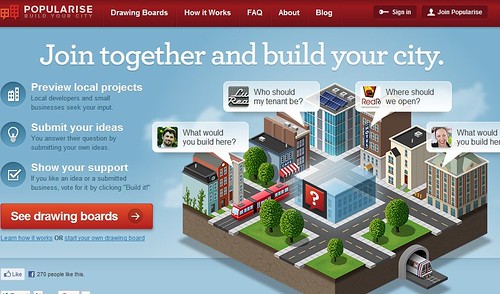(To badly paraphrase the Dylan lyric, "the debutante knows what you need, but I know what you want," the issue of getting the retail you want is much more than want, it's about what can be created, supported, and financed.)
While it looks cool, I am not a big fan of the Popularize.com "crowdsourcing" website that seemingly gathers information from residents about "what they want" to be built on various building sites. See the WAMU/DCentric article, "Crowdsourcing Neighborhood Changes." It's pretty clear from all sorts of surveys that predate what is now called "crowdsourcing" that people want coffee shops (especially Starbucks), restaurants, Trader Joe's type food stores, book stores, etc. for their neighborhoods.The issue isn't what people want so much as to how to get it.
It's pretty clear from all sorts of surveys that predate what is now called "crowdsourcing" that people want coffee shops (especially Starbucks), restaurants, Trader Joe's type food stores, book stores, etc. for their neighborhoods.The issue isn't what people want so much as to how to get it. E.g., last week I was a bit derisive about the new DC Vibrant Retail Toolkit in the blog entry "The primary ingredient for retail revitalization is (after planning) conviction," but I did print it out for deeper reading, and while I haven't read it yet, I did scan a couple pages (and yes it is going to be a very good resource (more about that some other time) even if I still believe that the biggest ingredient for retail revitalization that is missing in DC will still be missing after the distribution of the Retail Toolkit and that's conviction) and one of the pages outlines household population and income targets for various types of retail businesses.Anyway, my problem with crowdsourcing is that if you don't provide some base information and structured knowledge to help shape the discussion, you set up the opportunity for mismatched expectations and don't get enough in the way of useful information and knowledge. (Sort of like the comments on a typical story in an online newspaper, the comments can be good but mostly are drivel.)
Or (1) how to provide them with the retail that they want; (2) in terms of specific businesses, independent or chain; (3) in terms of how businesses, especially chains, rate/score neighborhoods and their willingness to locate there (e.g., to Starbucks, the store at 8th and D Streets SE on the Eastern Market Metro Station Plaza, in the heart of Capitol Hill, is an impoverished neighborhood); (4) the dictates of financing the building (banks prefer chains not independent retailers); and (5) capital formation for retail businesses.
To get all that to be congruent is difficult, and you need support systems for business proprietors so that they can develop robust concepts and operating systems so that their businesses will succeed over the long term, line up a good location and a favorable lease, and financing for their business.
And the neighborhood has to have the right kind of demographics necessary to support the business.

Key criteria in evaluating urban retail submarkets. Page 38 from the DC Vibrant Retail Toolkit.
And out of all that, traditionally, developers and property managers haven't gone out of their way to provide any of that kind of extra-normal assistance to actually develop, create, and nurture that kind of retail for their properties.
Also see the blog entry "
Store Siting Decisions" originally from July 2005. And while the overall circumstances are changing somewhat, as chain retailers are now more willing to consider center city markets than they were almost 7 years ago when I wrote "T
he future of urban retail isn't chains," the entry is still relevant, especially for marginal districts.
E.g., sure Walmart, a national chain, is entering the DC market in force, but it's not like other, more desirable chains are doing so, e.g., Trader Joe's hasn't expanded their store frontprint in the city from the one they have in the West End; you don't have a Kohls Department Store, etc.
There are exceptions. The Rouse Company's creation of Faneuil Hall in the early 1970s as a retail environment is one. It laid the basis for what are now known as "festival marketplaces."
But even over time, the company moved from the "one-off" retailer to chains, as evidenced by the store and restaurant mix in Harborplace in Baltimore, which features non-local brands such as California Pizza Kitchen.
Although note that one way to help fund retail that you want is by "crowdfunding" it. See "
'Go Local' means invest local" from
CityPulse (Lansing, MI).
Of course, for the big retailers, it's called financial incentives. For example, a payment of not quite $1.5 million was made to Trader Joe's to attract them to the West End DC location.
Labels: commercial district revitalization, real estate development, retail enterpreneurship development, retail planning





1 Comments:
It has been very useful, I was looking for something similar,
greetings and thanks.
Post a Comment
<< Home